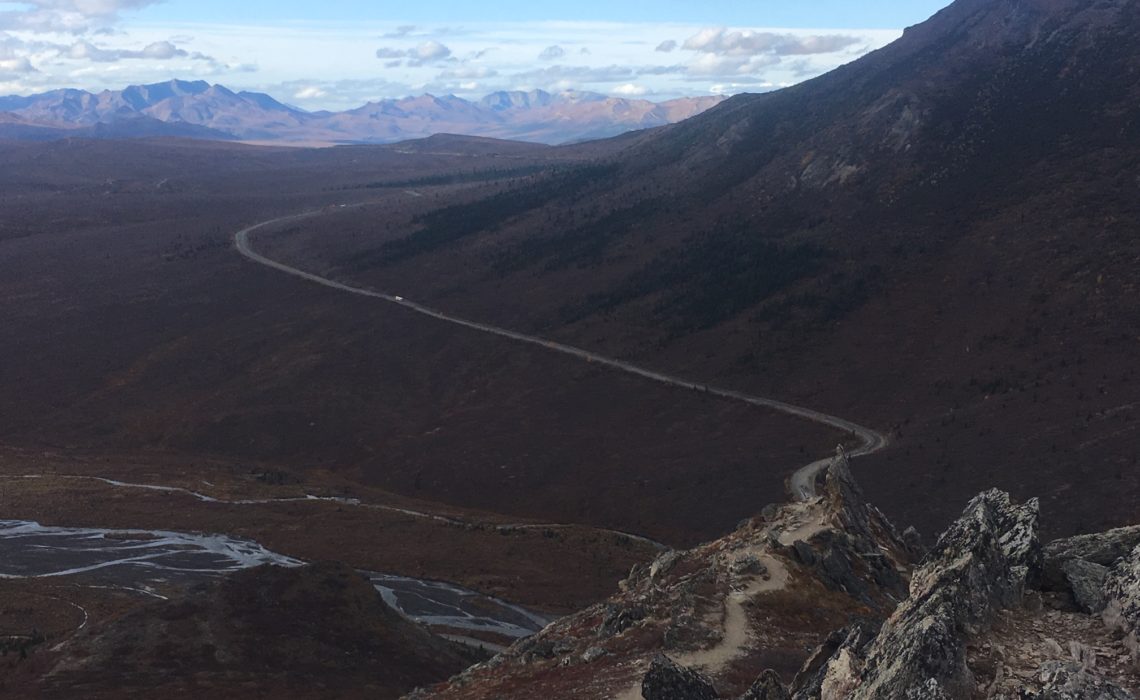
Driving the gravel road, I scanned the horizon for something moving. The tundra stretched for miles and miles with no trees blocking my view. It felt strange to experience so much wide open space at such a low elevation — less than 3,000 feet.
Such is life in Alaska.
I noticed a vehicle pulled over up ahead it’s blinkers on. Seeing a bus or car pulled over on the side of the road in a national park is a sign. There is wildlife nearby.
Pulling our rental car over, we peered down the hill.
“Bryon, it’s a grizzly! There he is! Oh my God!”
I’d seen the photos before — the lighter brown coat, classic hump behind the neck, up turned nose. But now I saw him in person.
With the grizzly over 100 yards away, I jumped out of the car to snap a couple of photos with my iPhone.
The guy in the white truck immediately barked at me.
“You need to get back in your car. You can’t be within 300 yards of a grizzly. We have a permit.”
“What, I didn’t know. It’s our first time here…” I stammered.
We sat in the car, transfixed. We watched as the bear grazed on the berries of bushes. He seemed oblivious to our presence, obsessed with eating instead.
I would later found out from the resident Park Ranger that indeed you are supposed to stay at least 300 yards away from a grizzly. That in fact, if one approached you, you need to stand your ground, and not back away or run. And yes, it is a good idea to carry bear spray on every hike.
After 15-20 minutes, we drove on. With the sun low in the sky, we still needed to set up our tent at the Teklanika Campground.
The next morning, we found ourselves waiting with others at the bus stop outside the campground. Any other park, we would have found ourselves back in our car to explore the rest of the park.
But the Denali experience is different.
It is far more structured, protecting both the safety of the wildlife and the visitor.
If you want to get to the end of the road at Denali, you will need to get on the bus.
The green buses zip up and down the dirt road, dust flying by. Drivers flash signs to each other, signalling wildlife up ahead. Visitors yell out as they see movement on the hillsides.
“Sheep at 2 o’clock on the southern hillside!”
Everyone immediately pulls out camera, smart phones and binoculars. We squint to see three pin-like white dots on the hillside.
On rare occasions, an animal happens to be right alongside the road as your bus rolls by. A huge bull moose sporting an impressive rack walked right up to our bus during our return trip. Everyone actually got great photos of the moose as it peered towards the bus.
Still, we got reminded to be careful.
“Please do nor stick your head or hands out the bus windows.” the bus driver whispered. Even he was mindful not to disturb the moose.
At times I felt restricted. Though we were allowed to drive into our campground, we were reminded that we could not move our car during our entire 3-night stay.
Stops on the bus were timed. If we wanted to stay longer, we could. However, we would need to make sure we got on the last bus, which left by 4 p.m. There would be no possibility of watching the sunset over Denali Mountain.
Is this better? Contract this very structured experience with the unstructured experience at nearby Rocky Mountain National Park. Visitors are allowed to drive where ever they like. There is no cap on the amount of “bus tickets” sold.
Instead, visitors are confronted with a lack of parking and trails teeming with people. Park rangers must constantly be on the look out for visitors approaching elk, trying to feed wildlife.
Is that really the wilderness experience that is ideal for visitors to the national parks?
I’m not sure either is right or wrong. But it surely gave me another way to think about experiencing the magic of national parks.

